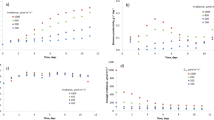Abstract
The effect of the rate of mixing on productivity of algal mass in relation to photon flux density and algal concentration was quantitatively evaluated in cultures ofSpirulina platensis grown in a newly designed flat-plate photobioreactor. Special emphasis was placed on elucidating the principles underlying efficient utilization of high photon flux density for maximal productivity of algal-mass. Whereas the rate of mixing exerted little influence on productivity and photosynthetic efficiency in cultures of relatively low algal density, its effect became ever more significant as algal concentration was increased. Maximal mixing-enhanced cell concentrations and productivity of biomass were obtained at the highest light intensity used. At each level of incident light intensity, maximum productivity and photosynthetic efficiency could be achieved only when algal concentration and mixing rates were optimized. The higher the intensity of the light source, the higher became the optimal culture density, highest algal concentrations and productivity of biomass being obtained at the highest light intensity used. The rate of mixing required careful optimization: when too low, maximal productivity resulting from the most efficient utilization of light could not be obtained. Too high a rate of mixing resulted in cell damage and reduced output rate.
Similar content being viewed by others
References
Burlew JS (1953) Chapter 17. In Burlew JS (ed.), Algae Culture from Laboratory to Pilot Plant. Carnegie Institution of Washington, Washington DC: 235–272.
De la Noüe J, Cloutier-Mantha L, Walsh P, Picard G (1984) Influence of agitation and aeration modes on biomass production byOOcystis sp. grown on wastewaters. Biomass 4: 43–58.
Erickson LE, Lee HY (1986) Process analysis and design of algal growth systems. In Barclay W, Mcintosh R (eds), Algal Biomass Technologies. Nova Hedwigia 83: 197–206.
Gittelson A, Hu Q, Richmond A (1996) The photic volume in photobioreactors supporting super-high population densities of the photoautotrophSpirulina platensis. J. appl. environ. Microbiol. (in press).
Goldman IC (1979) Outdoor algal mass cultures. II. Photosynthetic yield limitations. Water Res. 13: 119–136.
Grobbelaar JU (1989) Do light/dark cycles of medium frequency enhance phytoplankton productivity? J. appl. Phycol. 1: 333–340.
Grobbelaar JU (1994) Turbulence in mass algal cultures and the role of light/dark fluctuations. J. appl. Phycol. 6: 331–335.
Grobbelaar JU (1991) The influence of light/dark cycles in mixed algal cultures on their productivity. Bioresource Technol. 38: 189–194.
Guterman H, Ben-Yaakov S, Vonshak A (1989) Automatic on-line growth estimation method for outdoor algal biomass production. Biotechnol. Bioengng 34: 143–152.
Hall DO, Scurlock JMO (1993) Biomass Production and Data. In Hall DO, Scurlock JMO, Bolhar-Nordenkampf HR, Leegood RC, Long SP (eds) Photosynthesis and Production in a Changing Environment. Chapman & Hall, London: 425–444.
Hu Q, Guterman H, Richmond A (1996) A flat inclined modular photobioreactor (FIMP) for outdoor mass cultivation of photoautotrophs. Biotechnol. Bioengng (in press).
Kok B (1953) Chapter 6. In Burlew JS (ed.), Algal culture: from laboratory to pilot plant. Carnegie Institute Washington Pub. 600: 63–75.
Laws EA, Taguchi S, Hirata J, Pang L. (1988) Optimization of microalgal production in a shallow outdoor flume. Biotechnol. Bioengng 32: 140–147.
Laws ER, Terry KL, Wickman J, Challup MS (1983) A simple algal production system designed to utilize the flashing light effect. Biotechnol. Bioengng 25: 2319–2335.
Lee YK, Pirt SJ (1981) Energetics of photosynthetic algal growth: influence of intermittent illumination in short (40 s) cycles. J. gen. Microbiol. 124, 43–52.
Märkl H (1980) Modelling of algal production systems. In Shelef G, Soeder CJ (eds), Algae Biomass. Elsevier/North-Holland Biomedical medical Press: 361–383.
Marquez FJ, Sasaki K, Nishio N, Nagai S (1995) Inhibitory effect of oxygen accumulation on the growth ofSpirulina platensis. Biotechnology Letters 17: 225–228.
Phillips JN, Myers J (1954) Growth rate ofChlorella in flashing light. Plant Physiol. 29: 152–228.
Pirt SJ, Lee YK, Walach MR, Pirt MW, Balyuzi HHM, Bazin MJ (1983) A tubular bioreactor for photosynthetic production of biomass from carbon dioxide: design and performance. J. chem. Tech. Biotechnol. 33: 35–58.
Pulz O (1994) Open-air and semi-closed cultivation systems for the mass cultivation of microalgae. In Phang SM, Lee YK, Borowitzka MA; Whitton BA (eds), Algal Biotechnology in the Asia-Pacific Region. University of Malaya: 113–117.
Richmond A (1988) A prerequisite for industrial microalgaculture: efficient utilization of solar irradiance. In Stadler T, Mollion J, Verdus MC, Karamanos Y, Morvan H, Christiaen D (eds), Algal Biotechnology. Elsevier Applied Science Publishers Ltd, Essex: 237–244.
Richmond A, Grobbelaar JU (1986) Factors affecting the output rate ofSpirulina Platensis with reference to mass cultivation. Biomass. 10: 253–164.
Richmond A, Vonshak, A (1978)Spirulina culture in Israel. Arch. Hydrobiol. Beih. Ergebn. Limnol. 11: 274–280.
Stitt M (1986) Limitation of photosynthesis by carbon metabolism. Plant Physiol. 81: 1115–1122.
Terry KL (1986) Photosynthesis in modulated light: quantitative dependence of photosynthetic enhancement on flashing rate, Biotechnol. Bioengng 28: 988–995.
Torzillo G, Carlozzi P, Pusharaj B, Montani E, Materassi R (1994) A two-plane tubular photobioreactor for outdoor culture ofSpirulina. Biotechnol. Bioengng 42: 891–898.
Torzillo G, Giovannetti L, Bocci F, Materassi R (1984) Effect of oxygen concentration on the protein content ofSpirulina biomass. Biotechnol. Bioengng 26: 1134–1135.
Torzillo G, Pushparaj B, Bocci F, Balloni W, Materassi R, Florenzano G (1986) Production ofSpirulina biomass in closed photobioreactors. Biomass 11: 61–74.
Vonshak A, Abeliovich A, Boussiba S, Richmond A (1982) Production ofSpirulina biomass: Effects of environmental factors and population density. Biomass 2: 175–186.
Weissman JC, Goebel RP, Benemann JR (1988) Photobioreactor design: mixing, carbon utilization and oxygen accumulation. Biotechnol. Bioengng 31: 336–344.
Zarouk C (1966) Contribution a l'étude d'une cyanophycée. Influence de divers facteurs physiques et chimiques sur la croissance et la photosynthèse deSpirulina maxima. Ph.D. Thesis, Paris.
Author information
Authors and Affiliations
Additional information
Author for correspondence
Rights and permissions
About this article
Cite this article
Qiang, H., Richmond, A. Productivity and photosynthetic efficiency ofSpirulina platensis as affected by light intensity, algal density and rate of mixing in a flat plate photobioreactor. J Appl Phycol 8, 139–145 (1996). https://doi.org/10.1007/BF02186317
Received:
Revised:
Accepted:
Issue Date:
DOI: https://doi.org/10.1007/BF02186317




